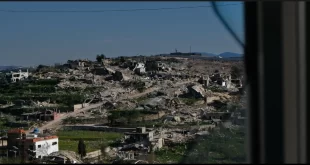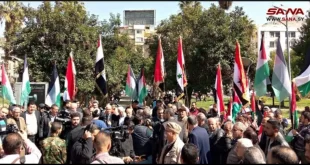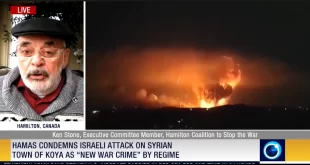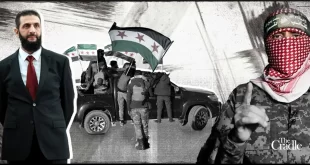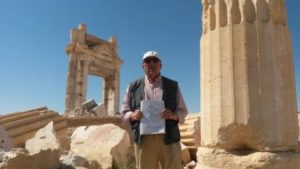
Apr 23, 2016, Consortium News
By pouring weapons and money into the Syrian war, the West and its Gulf state allies share in the guilt for the Islamic State’s partial destruction of Palmyra’s historic ruins, which Jeff Klein visited.
-Jeff Klein
ISIS/Daesh is on the retreat in Syria, which is very good news for the people of that beleaguered country and for the world. But the Syrian tragedy is far from over and rebuilding the country, even under the best circumstances of an end to the war, will take many years.
Our little international delegation — we were two Americans, a Canadian, two Norwegians, a Palestinian from Jordan and another Palestinian from Lebanon — got to see the evidence for this first-hand, along with the horrific devastation left in the wake of the ISIS occupation of the world-famous ancient city of Palmyra and the neighboring Syrian town of Tadmor.
The tour was arranged and led by a Palestinian organization based in Australia that is very supportive of the Syrian government and it was facilitated by the Syrian Ministry of Tourism and other government agencies.
It took some very intense negotiations with the authorities to secure visas, especially for the Americans, who are understandably viewed with some suspicion given the very hostile policies toward Syria by the U.S. government. Even more complicated efforts were necessary to get permission – from the Syrian security agencies, the Ministry of Defense and the Russian military mission in Syria – to visit Palmyra, which was only recaptured by the Syrian army on March 26. We were the very first group of international civilians to view the site and the aftermath of the battle that took place there.
Heading to Palmyra
Even with permission, traveling to Palmyra was not easy. Because the direct route northeast from Damascus was not yet safe, it was necessary to travel first due north to Homs and then east across the desert along a road only recently cleared of armed rebels. Exiting Damascus required a detour to the west in order to avoid a dangerous stretch of highway threatened by fighters in the rebel-controlled town of Douma, just north of the capital.
There were also frequent military checkpoints along the way, at each of which Qusay (everyone here is identified only by first name), our liaison with the government, had to negotiate passage and show various documents and permissions – along with our passports. The drive to Palmyra, which in peacetime would have taken maybe two hours on the direct route, took us nearly six hours to complete.
Even in the tense security situation, though, at least one Syrian officer at a checkpoint on the outskirts of Damascus had not lost his sense of humor. When told that we were an international group on the way to visit Palmyra, his parting words after checking our documents was “Say hello to Zenobia!” The officer was jokingly referring to the famous queen of Palmyra who led a doomed revolt against the Roman Empire in the third century AD and has been adopted – quite ahistorically — as a kind of ancient Syrian freedom fighter. We took to calling the one Norwegian woman in our group “Zenobia” after that.
We picked a military escort in Homs. Colonel Sameer packed a Makarev automatic pistol in a shoulder holster and carried a gym bag inside of which it wasn’t hard to make out the bulges of a Kalashnikov assault rifle and a bunch of grenades. Comforting.
With the Colonel riding shotgun in the front of our bus, it was relatively simple to negotiate the frequent military stations and roadblocks along the rest of the way to Tadmor/Palmyra. As we approached the town, Colonel Sameer pointed out where Daesh suicide bombers had attacked his troops and we observed other signs of war damage – bullet-pockmarked and partially destroyed buildings, downed electrical transmission pylons, burned-out vehicles. But nothing prepared us for the utter devastation of Tadmor when we arrived.

The streets were guarded by soldiers and the somewhat more ragtag National Defense Forces militia fighters in various stage of partial uniform. (Photo credit: Jeff Klein)
Reclaiming Civilization
The town had suffered both from the Daesh occupation and even more so from the fighting to retake it. There was hardly an undamaged building to be seen and although the rubble blocking the streets had largely been cleared, there were many areas where only the skeletons of destroyed structures remained. And the retreating Daesh fighters had left the town and the ruins riddled with mines and booby traps, which took a huge effort, not yet completed, to disarm.
Most of the inhabitants had fled Tadmor when it was taken over by Daesh last summer. But during our visit, the place was crowded with busloads of former residents collecting their personal possessions and household furnishings. Only in the previous few days — weeks after retaking the town and with extensive de-mining — was it possible for any of them to return safely to retrieve any of their belongings that survived the destruction. But the town was still uninhabitable for civilians due to the severe damage and the lack of electricity or water, so they were packing what they could into buses and trucks to take away.
The Ruin of the Ruins
The systematic vandalism and destruction by Daesh at the historic archaeological site of Palmyra has been widely reported, but viewing the damage was still a shock. Our cultural guide Antoine (“Tony”), who had led countless groups to visit the Palmyra, was brought to tears.
“Ya haram” (“shameful”), he muttered repeatedly as we saw the destroyed former monumental archway leading into the ancient city and the shattered remains of the Temple of Baal, both of which the Daesh fighters had blown up when they took the city last summer.
Only the remains of the ancient theater had been left untouched, possibly as a monument to the brutal execution of 25 captive Syrian army prisoners that Daesh had carried out and filmed for distribution on the web.
We had to wait a while before entering the theater ourselves because there was a high-ranking group of Russian military officers visiting inside. Accompanying them was a contingent of very steely-eyed special forces soldiers who, despite the heat, wore full battle gear – body armor, helmets, boots, and gloves with fingers poised close to the triggers of their automatic weapons.
There is a large contingent of Russian military engineers and technicians engaged in the ongoing effort to disarm mines and booby traps in the city and among the ruins. They have their own camp just outside the town. Near the ruins is a former restaurant whose red sign announces, in Cyrillic and English, that it is the “Sappers Café.”
While we toured the site, explosions could be heard at regular intervals nearby and we could see the smoke of detonated mines.
When the officers and their guards exited the theater, our group leader Khaled, who like many Palestinians of his generation had received a scholarship to study in Soviet Leningrad, enthusiastically greeted the soldiers in fluent Russian, somewhat to their surprise.
Colonel Sameer had earlier told us that we could photograph anything we wanted – except the publicity-shy Russians. Given the cordial chitchat with Khaled, I thought I might ask if I could take a picture. The Russian translator answered, to everyone’s amusement, with an emphatic monosyllable – “NYET.”
Confronting the Devastation
Leaving the newly vandalized ruins of ancient Palmyra and exiting past the devastation of modern Tadmor, it was hard to know how to feel. Was the recapture of this place a turning point or just one more chapter in a terrible war that has no end in sight?
The U.S. and its allies seem determined to bleed Syria to death, but the country refuses to expire. Russia, Iran and Hezbollah are supplying Syria with enough aid to stave off a military defeat, though not necessarily enough to achieve a decisive victory.
The U.S. has just pledged to supply the “moderate” rebels with new and more dangerous weapons that, as before, will no doubt make their way to Al-Qaeda and Daesh. The Syrian Arab Army is also facing new attacks in the north and around Aleppo, led by the Nusra front and its U.S.-supported allies, who have apparently taken advantage of the cease fire to re-arm and reorganize for new offensive actions.
The likelihood of an early comprehensive victory by either side seems remote. So, what does the future hold for Syria?
Nearly everyone we met – and they were by no means all uncritical supporters of the Assad regime – told us that they believed any hope for Syria required, first of all, the defeat of the armed rebels and an end to foreign intervention in their country.
This was especially the sentiment of Christian and Druze religious representatives, along with ethnic minorities and secular people of all faith backgrounds. Together they undoubtedly comprise a majority of the Syrian population.
Regardless of the legitimate grievances at the root of the crisis which began in 2011, and even if the opposition may not all be “terrorists,” as the Assad regime charges, the armed rebels now overwhelmingly represent Sunni fundamentalists of various stripes, whose vision for Syria is a religiously exclusive Islamic state, not a secular democracy. This is true for the most part of the so-called “moderate” opposition which the U.S. and its allies are arming and financing, not only the recognized extremists and foreign fighters in ISIS/Daesh and Al Qaeda’s Nusra Front. Democratic and secular oppositionist are nearly insignificant on the battlefields.
Lebanon’s bloody civil war lasted 15 years; Syria’s war, now in its sixth year, may not be shorter. Lebanon today is mostly free of internal violence, even if it remains a country nearly without a functioning state; in Syria the state remains but it has lost much of the country.
Restoring Life
Nevertheless, amid the violence and despair of the current situation in Syria, there are also signs of hope and resilience. In central Damascus the shops and restaurants are open, even if the tourist hotels remain nearly empty. In the Old City’s Bab Touma neighborhood where we stayed – especially since the partial cease-fire agreement that was established earlier this year has minimized the rebel mortar and rocket attacks – the streets were crowded with students and shoppers.
There was a vibrant nightlife at many cafes and eating places, often with live music and spirited diners who took to spontaneous dancing and singing along to the music. But there were also military checkpoints along the major streets and at the gates to the town.
In Homs, the old city which was under rebel control and the scene of intense fighting until 2014, has been nearly totally destroyed. But the historic Khaled Ibn Walid mosque is now the site of a major restoration project. In the ruined old covered market, a few storekeepers have re-opened for business and several shops are undergoing repairs.
In another part of the city, not far from where the courageous Dutch Jesuit Frank van der Lugt was murdered by the retreating rebels, the vandalized Syrian Orthodox Notre Dame de la Ceinture is also undergoing restoration.
The Homs district governor says there are plans to build 100,000 new housing units to replace what was destroyed. Where the money will come from to finance this work is not clear in a Syria whose economy has been devastated by the war and whose currency has lost 90 percent of its value compared to the U.S. dollar.
Remembering Past Tragedy
The two Palestinians on our Syria delegation embodied an earlier tragedy in the region. In 1948, Khaled’s parents fled to Jordan from Kufr Saba — now Kfar Sava in today’s Israel. He spent part of his childhood in the Gulf states, where his father had found a job. After studying engineering in the Soviet Union, Khaled returned to Jordan, lives in Amman and carries a Jordanian passport.
Wesam’s parents were from a small village near Haifa and they fled in 1948 to Lebanon, where he was born. He is without citizenship in any country and carries only a Palestinian “travel document” that serves instead of a passport. His wife Lina’s family is originally from Ramle, now also in Israel. She grew up in Ramallah and eventually moved with her family to the Yarmouk refugee camp in Damascus, where she met and married Wesam.
After their house on the outskirts of the camp was destroyed in the fighting few years ago, they moved back to Lebanon. There they live in Beirut’s very crowded Burj el-Barajneh refugee camp, whose population has been recently swelled by an influx of thousands of impoverished Syrians escaping from the war in their country.
Wesam says he is saddened to see so many Syrians fleeing their country, but he understands their decision, even if he believes it is wrong.
“Who will build the country again if everyone leaves,” he asks. “Syrians should not make the same mistake that we Palestinians made in 1948. If you leave your country, maybe you will never be allowed to return.”
Yet, despite everything, many Syrians remain determined to stay. In Old Homs, across the street from the Syrian Orthodox church, a new café is one of the first re-opened shops in the area. It was filled with young men and women taking refreshments and socializing together – a scene unthinkable in most zones now under rebel control. On the wall is painted a statement of hope, referencing some famous verses by the Palestinian poet Mahmoud Darwish, who is also revered by Syrians:
In this neighborhood,
WE SUFFERED,
We went through
difficult times and
We fled our homes.
Today we may still
Suffer, difficult
Times remain, but
WE ARE
HOLDING ON
TO OUR LAND..
Believing the Sun
Will Rise Again..
Jeff Klein is a retired local union president, a long-time Palestine solidarity activist and a board member of Mass Peace Action. [This article previously appeared at Mondowweiss, http://mondoweiss.net/2016/04/say-hello-to-zenobia-a-report-from-palmyra-rising-from-the-ashes/]
 Syria Support Movement solidarity with the Syrian people
Syria Support Movement solidarity with the Syrian people

